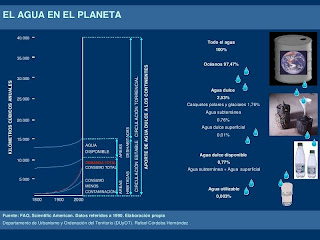|
| |
The water content of the planet is estimated at 1,300 trillion liters. The majority,97.47%, the oceans store, the rest is fresh water. Freshwater is a limited resource and its quality is under constant pressure. Drinking water is a scarce commodity in the amount of energy you need to invest in their training. The water of the poles is not directly usable on a large scale, and it is necessary to resort to the aquifer, some of which are fossil, ie, non-renewable, and rivers. Preserving freshwater quality is important for the supply of drinking water or food production. The largest percentage of this water is in ice caps and groundwater.
This amount has been around forever for the Earth, creating and preserving life on it.We currently have the same amount that was given to the dinosaurs 65 million years. | |
| Distribución de recursos hídricos en el mundo | |
The scarcity of fresh water is one of the main environmental problems before we met.Can easily say that we are reaching the limit of extracting fresh water from thesurface, but consumption is increasing. However, a major threat is the effect climate change will have on the hydrological cycle and freshwater availability. Basicallyconditions will worsen the shortage of areas that are already dry (less rain and more evaporation). Currently 20% of the population has no access to water of sufficient quality and 50% lack sanitation. Africa and Western Asia are the areas of greatestdeprivation. In simple terms we could say that in the richer countries the water problem especially affects the conservation of nature and the potential for economic growth while in the south, besides all that, the lack of drinking water is the direct causeof disease as diarrhea and cholera kill 15 million children each year.
To ensure our basic needs we need 20 to 50 liters of drinking water free of pollutantsper day. A newborn in a developed country consumes an amount of water 30 to 50 times greater than that of a newborn in a developing country. | |
| Distribución de recursos hídricos en Europa | |
The situation of water distribution in Europe is not particularly serious. Water demandis in decline due to improved management, reuse and industrial process changes.There is an abundance of dams and water infrastructure. The biggest problem has always been the industrial pollution of rivers, especially in Central and Eastern European countries. However, it is producing a significant overall improvement, especially in the situation of the rivers, through the treatment plant expansion, tightening control and legislation and the use of structural funds for improvements, infrastructure and environmental research.
Fuente: European Envirovement Agency
| |
| Consumo de agua por continentes y sectores | |
The water consumption is carried agricultural bound 70% of fresh water consumed by the use of inappropriate irrigation techniques. Industrial consumption will double in 2050 and rapidly industrializing countries like China will be multiplied by 5. Urban consumption also increases with income per capita, especially in recreational uses(golf courses, parks and gardens, etc.) and from tourism.Worldwide, the global freshwater consumption has multiplied by 6 between 1900 and 1995 while populationhas only done by 3.
| |
| Precio del agua | |
Water has always had a price, since the first settled communities began to control access to strategically placed springs and streams. The creation of cities demandedlarge expenditures on wells, aqueducts and cisterns. In our era, urban expansion, agricultural and industrial water has turned into something very valuable in many parts of the world. In fact in some countries, water from illegal vendors is over 100 times more expensive than water supplied by the network connection.The "water price" is defined as "the aggregate or marginal users pay for all services related to water (egwastewater treatment), including the environmental aspect."
| |
| Consumo diario doméstico per cápita | |
The volume of water that is spent on household grows from year to year. The installation of economizers and a change of habits are the steps we must take tospend less.
But more important are the differences between consumption across countries. ThusIndia consumes a total volume of water for domestic use very similar to the average European spends only wash dishes and cook. The authors make accounts' and acountry like ours, you might spend only domestic consumption up to 6 times more water than India, but if we also take into account the different populations of both countries the figures are to take their hands head. | |
In Spain, where droughts are becoming increasingly frequent and virulentcontroversies over the supply and use of water is acute. Nobody seriously facing as vital factors in the shortage of water such as: climate change, lack of forests (Spain has lost more than 4 million hectares in the last decades), pollution of water (about 33,000 cubic hectometres water quality is fair, poor or low and can not be used), losses in the supply and pipes (about 20% of piped water is lost to leakage) wastefulirrigation systems (installation of micro irrigation systems could be reduced by more than 40% - some 10,000 cubic hectometres - water use in agriculture), the excessive consumption of each one of us (after U.S., Russia and Canada are the fourth largest consumer country water in the world, with 1,174 meters cubic per capita and year).
|









